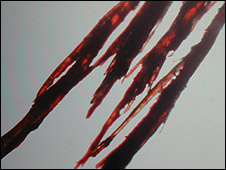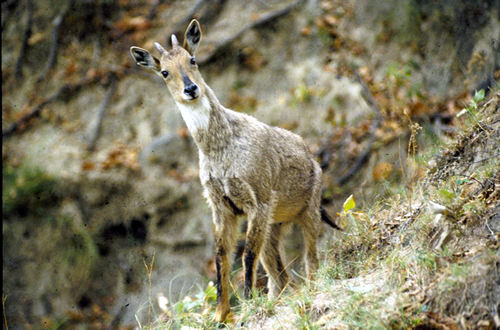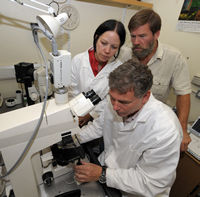
The “Yeti hair” sample.
October 14, 2008

The “Yeti hair” sample.

Goral (Rajaji National Park): Photo by AJT Johnsingh
Hairs believed to belong to a Yeti in India are actually from a species of a goat-antepole-like animal, the goral, US scientists have found. Nevertheless, this discovery is exciting the specialists involved in the finding.
DNA tests on the hairs, which came from the Indian state of Meghalaya, show they are from the Himalayan goral (Nemorhaedus goral), an animal with a grey-brown coat.
The Himalayan goral, also known as the gray goral, is a small, rough-haired, cylindrical-horned ruminant native to the Himalayas. In the past, it was also known as Urotragus goral. The Himalayan goral is found in the forests of the Himalayas, usually between 1000 and 4000 meters in elevation. Groups of animals typically occupy a territory of about 100 acres.
The goral is a different species than the similar-looking, Himalayan serow (Capricornis thar) or other species of serow, the animal from which hides have been used to make the imitative Yeti skullcaps found in ritualized use in Nepalese, Tibetan, and other Himalayan religious sites. The serows are six species of small goat-like or antelope-like mammals of the genus Capricornis. All six species of serow were until recently also classified under Naemorhedus, which now only contains the gorals. They live in central or eastern Asia.
The Yeti is said to be an ape-like creature sometimes called mande barung, or forest man in the locale where the hairs were gathered. It was allegedly sighted by a forester in 2003.
Ape expert Ian Redmond carried out a preliminary series of tests on the hairs earlier in 2008, which proved inconclusive.
He said: “We always knew that the link between the sightings of the Indian Yeti and the finding of the hairs was purely circumstantial. Nevertheless, the DNA test is an interesting result because the reported location where this sample was collected is way south of the known range of the goral species, which is said to live between 1,000 to 4,000 metres up in the Himalayas. Perhaps we have a more modest discovery – extending the known range of the goral rather than confirming the existence of the lowland Yeti.”
The BBC was given the hairs by passionate Yeti believer Dipu Marak, who retrieved them from a site in dense jungle after the mande barung was allegedly seen by a forester for three days in a row in 2003.
Marak said that the hairs could have provided compelling evidence of the existence of a black and grey ape-like animal which stands nearly 10 feet or about 3 meters tall.
“While these results are discouraging, it does not affect my firm conviction that there is a Yeti-like creature out there,” Marak said. “It has been seen too often for it to be dismissed as nothing more than a myth.”
In recent years different witnesses in the West, South and East Garo hills of Meghalaya say that they have seen the creature, which Marak estimates to weighs about 300kg (660lb) and is herbivorous, surviving on fruit, roots and tree bark.
Redmond and others said that initial microscopic tests on the hairs were “potentially very exciting” as they bore a “startling resemblance” to similar suspected Yeti hairs collected by Everest conqueror Sir Edmund Hillary.
After the microscope tests, the hairs were sent to a lab in the US for DNA analysis. By a “process of elimination” the hairs from India were compared with hairs from other animals known to live in the area around the Garo hills.

The first series of tests were carried out at Oxford Brookes University in central England with award-winning primatologist Anna Nekaris and microscopy expert Jon Wells from the university’s anthropology department.
Using some of the most sophisticated microscopes in Britain, the hairs were magnified up to 200 times and then compared with a database of other hairs provided to Ian Redmond from Oxford’s Natural History Museum and the primatology department at Oxford Brookes University.
After the tests were completed, Redmond – who is also a senior consultant for the UN’s Great Ape Survival Project – and Nekaris were able to rule out the “obvious candidates” to whom the hairs might belong.
However, the hairs were then sent to the US for further tests where the link with the goral species identification was established.

As noted, originally, scientists compared the 2003 Yeti hair samples favorably with the Yeti hair brought back by Edmund Hillary. The Hillary hair samples from 1960 were mostly from only one of the Buddhist monasteries his expedition visited, the Khumjung Lamasery. The famed supposed Yeti scalp from this Buddhist monastery was brought back to Paris and Chicago by Edmund Hillary and Marlin Perkins.

Bernard Heuvelmans and other mammalian experts examined it along the way. Hillary and the publicity from his World Book expedition claimed the Buddhist monks said the Khumjung skullcap was “from a Yeti.” But as members of the 1954 Daily Mail expedition (e.g. Charles Stonor and Ralph Izzard) had been writing for years, and also noted by Bernard Heuvelmans and Ivan T. Sanderson, these scalps were made “in imitation of Yeti.” Therefore, it was not a surprise when it was discovered that the animal from which the skullcaps were made was the serow.
Sources: BBC, ITN, Tom Slick: True Life Encounters in Cryptozoology (Fresno, CA: Craven Street-Linden Press, 2002).
About Loren Coleman
Loren Coleman is one of the world’s leading cryptozoologists, some say “the” leading living cryptozoologist. Certainly, he is acknowledged as the current living American researcher and writer who has most popularized cryptozoology in the late 20th and early 21st centuries.
Starting his fieldwork and investigations in 1960, after traveling and trekking extensively in pursuit of cryptozoological mysteries, Coleman began writing to share his experiences in 1969. An honorary member of Ivan T. Sanderson’s Society for the Investigation of the Unexplained in the 1970s, Coleman has been bestowed with similar honorary memberships of the North Idaho College Cryptozoology Club in 1983, and in subsequent years, that of the British Columbia Scientific Cryptozoology Club, CryptoSafari International, and other international organizations. He was also a Life Member and Benefactor of the International Society of Cryptozoology (now-defunct).
Loren Coleman’s daily blog, as a member of the Cryptomundo Team, served as an ongoing avenue of communication for the ever-growing body of cryptozoo news from 2005 through 2013. He returned as an infrequent contributor beginning Halloween week of 2015.
Coleman is the founder in 2003, and current director of the International Cryptozoology Museum in Portland, Maine.
Filed under Abominable Snowman, Breaking News, Cryptomundo Exclusive, Cryptotourism, CryptoZoo News, Cryptozoologists, Cryptozoology, Evidence, Forensic Science, Yeti